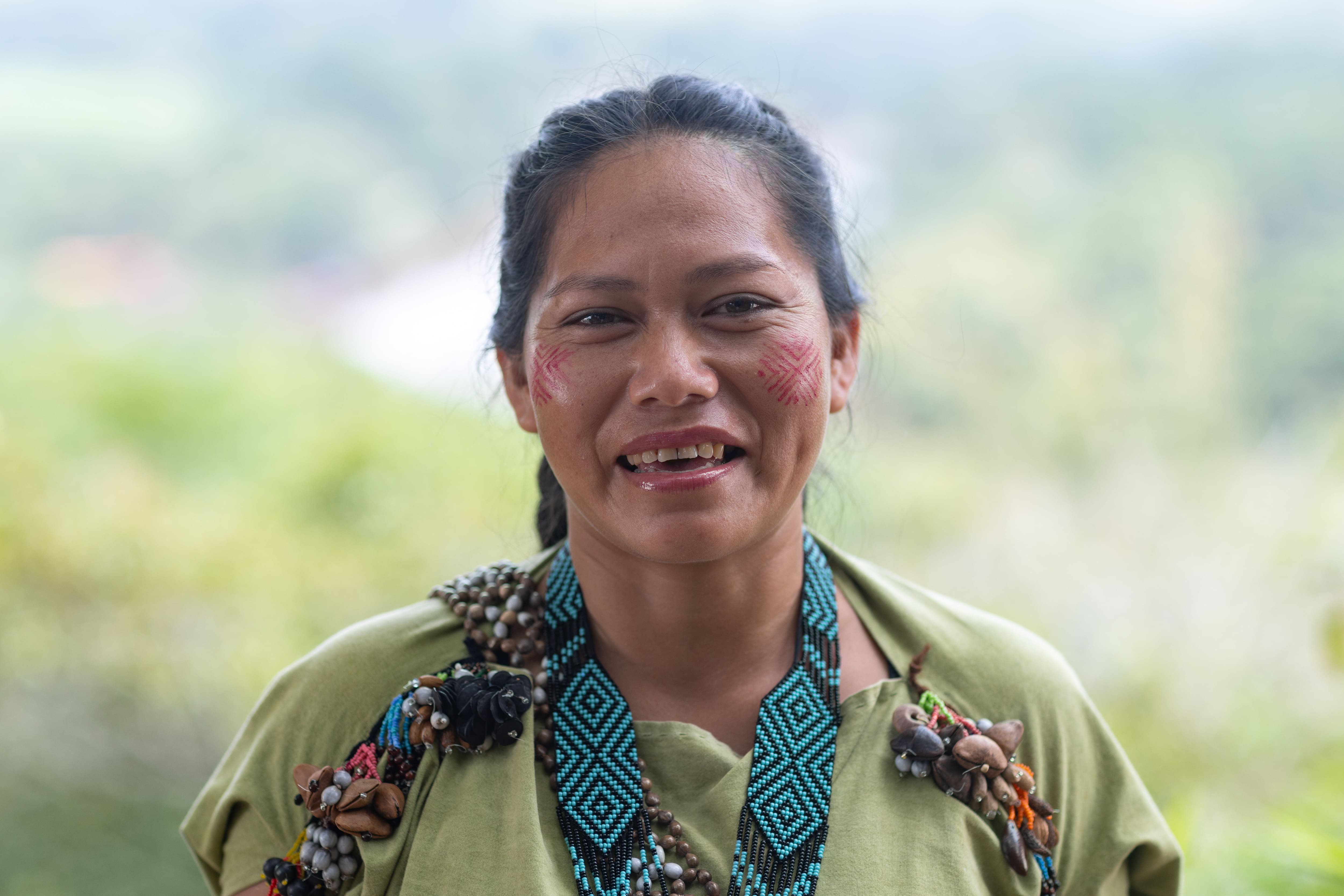‘In Koshireni we are few, but we have a very big heart,’ says Imelina Benavides, capturing the essence of the community.

© Marlon del Águila / Conservación Internacional
The native community of Koshireni, located in the Yurúa river basin (Ucayali) on the border between Peru and Brazil, is home to seven Yanesha and Asháninka families. It is part of the Yurua Community Conservation Association (ACCY), that managemes and conserves more than 40,000 hectares of forest protected by the Yurua Conservation Concession.
Its inhabitants migrated from regions of the central jungle of Peru and have maintained a rich cultural heritage intertwined with the unique biodiversity of the region. Imelina Benavides, was born in the Yanesha community of Loma Linda (Pasco), migrated to Koshireni in 2012 and decided to make this place her home. ‘My brothers ask me why I am so far away; it is not easy to leave Koshireni, but I like it here. My children are running around, they have the countryside free, very different from the city,’ says Imelina.
However, life in Koshireni is not without its difficulties. Encroachment by loggers and fishermen from neighbouring communities has jeopardised access to resources, and the lack of basic services has forced many families to migrate. Currently, only three families reside permanently in Koshireni. This reality has made the development of a Life Plan not only a priority, but a necessity to ensure a sustainable future for generations to come.

©Yunkawasi
The Pathway to the Life Plan
The Life Plan is a reflection of the community's values and aspirations. Priority issues include protecting the territory from encroachment, improving basic services and creating sustainable economic opportunities such as agriculture, animal husbandry, fishing and handicrafts.
‘The Life Plans is a document that allows us to plan and establish a path of improvement and development for the communities. It shows the path to follow and contributes to the internal governance of the communities, but also to external governance with other organizations, including state entities, as they share their vision for the future management of their territory’, says Mirko Ruiz, Senior Gender and Safeguards Coordinator at Conservation International Peru.
Imelina has become an emerging leader within her community. Her participation in the Amazon Indigenous Women's Fellowship Program has given her the necessary tools to lead the elaboration of the Koshireni Life Plan. ‘I am not only a representative of the board of directors as secretary, but also as an indigenous woman I represent the other women in my community,’ she says.
The creation of Koshireni’s Life Plan has not been easy. It was initiated after the community assembly made the decision to do so, and the community has worked together to define its priorities and goals for the next 10 years. Imelina has played a crucial role in motivating her neighbors to actively participate, ensuring that the voices of women, youth and children are heard. ‘This document will help us to develop work plans on important issues such as health, sustainable economy, women's participation and territorial management,’ explains Imelina.

©Yunkawasi
In addition, behind the success of the elaboration of the Koshireni Life Plan is the technical support of organisations such as Yunkawasi, which have provided advice and follow-up to the community in this process. During the last year, Koshireni was able to leverage additional funds to begin implementing the actions and goals proposed in its Life Plan. This fund was granted by the organization Fondo Socioambiental del Perú and will allow the strengthening of the community's artisanal activity.
‘I have witnessed how little by little Imelina has strengthened her leadership skills, leaving behind insecurities and strengthening her capacities for the wellbeing of her community,’ says Teresa Salas, Technical Field Coordinator of the Yunkawasi Civil Association.
‘At the beginning I felt nervous, but happy. Socializing with partners, going out and speaking in public made me scared,’ confesses Imelina. However, thanks to the support she received from the Amazon Indigenous Women's Program, she managed to overcome these fears. ‘The trainings have helped me, I feel stronger, I have learned a lot, and I now know that women can also lead these processes’, she adds.
A Bright Future for Koshireni

©Yunkawasi
Imelina's vision for Koshireni is clear: a future in which the community is an example of sustainable development, where its inhabitants can live in harmony with their environment, preserving their customs and traditions. ‘We now have a local control and surveillance center, where we patrol our territory’. This love for her territory is reflected in her commitment to conserve and support the leadership of the Arankom Artisans Association, which is made up of eight women and five men. ‘We applied for new funds and now we have an artisan's house. We are looking for partnerships to see where and how to sell our handicrafts outside Breu,’ she says enthusiastically.
‘We can say now that Koshireni has a planning and management tool, which allows the community to clearly establish their vision, their wishes, and their desires that contribute to a better life,’ says Teresa Salas.
Imelina Benavides' work in the Koshireni community is not only a testament to her dedication, but also an example of the transformative power that indigenous women can have when given the necessary support. Through the Koshireni Life Plan, Imelina is helping her community to forge a prosperous and sustainable future, where coming generations can live in harmony with nature and their cultural heritage.
WOMEN IN CONSERVATION
Women in Conservation is an initiative led by Conservation International Peru that supports women's leadership through a dedicated fund aimed at generating opportunities and strengthening the leadership of women from local and Indigenous communities who are contributing to climate change solutions. This has grown out of the Amazon Indigenous Women's Programme, which supports projects such as those of Imelina Benavides, and highlights indigenous knowledge and traditions. To date, more than 63 indigenous women and 9 women located in the Alto Mayo Protected Forest have been strengthened by this initiative.